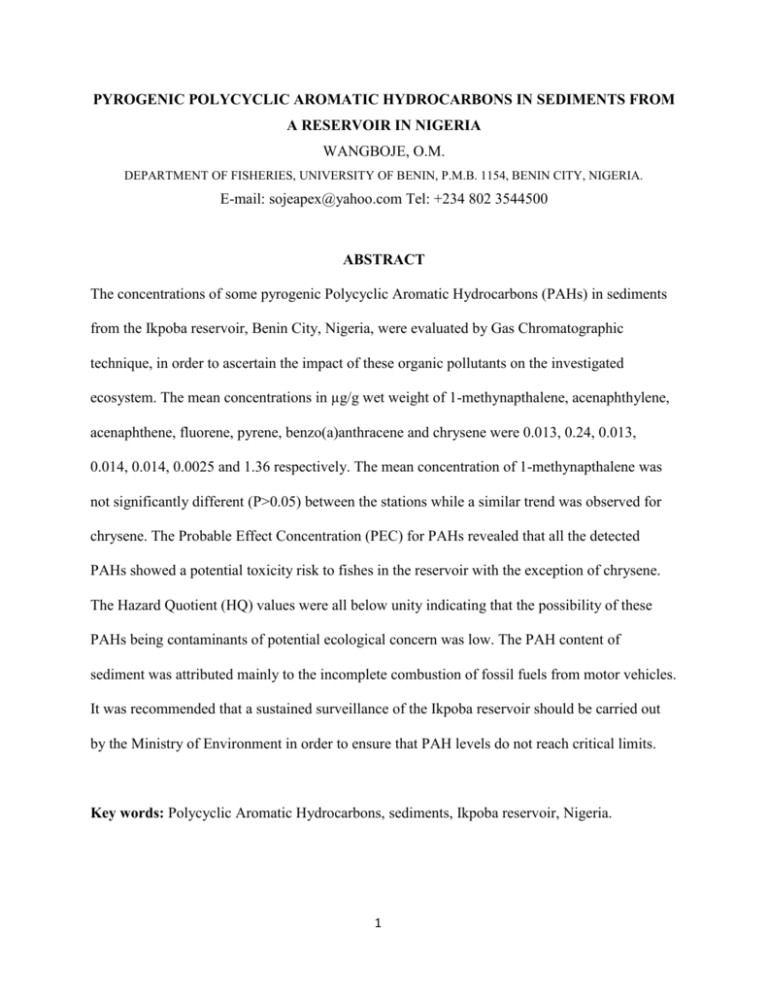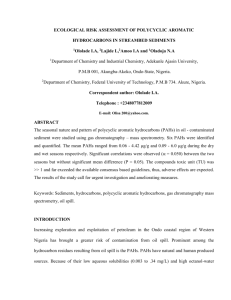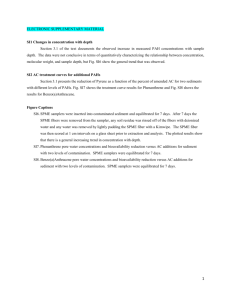pyrogenic polycyclic aromatic hydrocarbons in sediments from a
advertisement

PYROGENIC POLYCYCLIC AROMATIC HYDROCARBONS IN SEDIMENTS FROM A RESERVOIR IN NIGERIA WANGBOJE, O.M. DEPARTMENT OF FISHERIES, UNIVERSITY OF BENIN, P.M.B. 1154, BENIN CITY, NIGERIA. E-mail: sojeapex@yahoo.com Tel: +234 802 3544500 ABSTRACT The concentrations of some pyrogenic Polycyclic Aromatic Hydrocarbons (PAHs) in sediments from the Ikpoba reservoir, Benin City, Nigeria, were evaluated by Gas Chromatographic technique, in order to ascertain the impact of these organic pollutants on the investigated ecosystem. The mean concentrations in µg/g wet weight of 1-methynapthalene, acenaphthylene, acenaphthene, fluorene, pyrene, benzo(a)anthracene and chrysene were 0.013, 0.24, 0.013, 0.014, 0.014, 0.0025 and 1.36 respectively. The mean concentration of 1-methynapthalene was not significantly different (P>0.05) between the stations while a similar trend was observed for chrysene. The Probable Effect Concentration (PEC) for PAHs revealed that all the detected PAHs showed a potential toxicity risk to fishes in the reservoir with the exception of chrysene. The Hazard Quotient (HQ) values were all below unity indicating that the possibility of these PAHs being contaminants of potential ecological concern was low. The PAH content of sediment was attributed mainly to the incomplete combustion of fossil fuels from motor vehicles. It was recommended that a sustained surveillance of the Ikpoba reservoir should be carried out by the Ministry of Environment in order to ensure that PAH levels do not reach critical limits. Key words: Polycyclic Aromatic Hydrocarbons, sediments, Ikpoba reservoir, Nigeria. 1 INTRODUCTION Essentially, Polycyclic Aromatic Hydrocarbons (PAHs) are organic compounds that are formed through the combination of two or more benzene (aromatic) rings. It has been recognised that environmental contamination by these compounds has steadily increased in recent years around the world thus raising concern amongst scientists and the public (Van Metre et al., 2000). Members of this class of compounds have been identified as exhibiting toxic properties and for this reason the United States Environmental Protection Agency (USEPA) has recommended their monitoring in environmental media (National Research Council, 1997). Furthermore, it has been recognised that PAHs are of great concern for aquatic biota because of their carcinogenic, teratogenic, mutagenic properties and their ability to biotransfer along food webs (Wangboje, 2013). Contributing to the PAH burden of inland waters in Africa are population explosion, rapid urbanization and industrialization (Calamari and Naeva, 1994). Polycyclic Aromatic Hydrocarbons are lipophilic, possess low solubility and volatility hence they are able to concentrate to harmful levels in aquatic environments through biomagnifications and biogeochemical processes (Duke, 2008). In addition, the lipophilic nature of PAHs enable them to easily accumulate in aquatic organisms including fin fish and shell fish thus posing potential health risks to man who may eventually consume such contaminated food (Ndiokwere, 2004). The physical and chemical characteristics of PAHs vary with molecular weight and PAH resistance to oxidation, reduction and vapourization increases with increasing molecular weight whereas the aqueous solubility of these compounds decreases. As a result, PAHs differ in their behavior, distribution in the environment and their effects on biological systems (United States Department of Health and Human Services, 2002). It has been reported that sediment dwelling organisms are more likely to be adversely affected by PAHs as the sediment acts as a sink for 2 organic pollutants including PAHs (Environment Australia Technical Report, 1999). Polycyclic Aromatic Hydrocarbons (PAHs) never occur as individual compounds in the environment as they occur as a mixture of many other PAHs which may compound their toxicological effects on the environment (Mottier et al., 2000). The main sources of PAHs in the environment include forest fires, natural petroleum seepage, combustion of fossil fuel, coal burning and the use of oil for cooking and heating. Other sources include domestic and industrial waste waters and sewage (Dhananjayan and Muralidharan, 2012). Although the extent of accumulation of PAHs in sediment is affected by such environmental factors as organic matter, structure and particle size distribution, microbial population, presence of toxic compounds, the physical and chemical properties of the PAHs, they may often be found near emission sources (Wilson and Jones, 1993). The present study was conducted on the Ikpoba reservoir which is located within Benin City, Edo state, southern Nigeria. The reservoir was constructed for the supply of drinking water to inhabitants of the City and environs and also serves as a source of valuable fisheries resources. The reservoir is impacted by effluents from surrounding communities which has necessitated the conduct of several ecotoxicological studies (Oronsaye et al., 2010; Wangboje and Oronsaye, 2012; Wangboje and Ekundayo, 2013; Wangboje and Oronsaye, 2013). However, the aforementioned studies dwelt exclusively on heavy metals. This study was thus designed to investigate the PAH profile of the reservoir using sediment as the test environmental matrix in order to fill the gap in knowledge regarding the contaminated status of this ecosystem. Sediments are repositories for both organic and inorganic contaminants and are thus essential components of ecological risk assessments as they can indicate long-term impact of chemical contaminants in aquatic ecosystems. 3 MATERIALS AND METHODS The study area The study area is gridlocked between Latitude 6.5° N and Longitude 5.8° E in Benin City, Nigeria and falls within the Tropical Rain Forest Belt. Details of the study area have been described extensively by Wangboje and Ekundayo (2013) while the geomorphologic characteristics of the same area have been described in detail by Asuen and Oronsaye (1990). Sediment samples were collected with an Eckman grab sampler from four stations established within the reservoir namely, Okhoro station, Midpoint station, Low lift pump station and Ekiuwa station. The Okhoro and Ekiuwa stations are adjacent to the Okhoro and Ekiuwa communities of the City respectively while the Midpoint station is approximately equidistant between the Okhoro and Low lift pump stations. It is at the Low lift pump station that water is pumped out for treatment by the State Urban Water Board. Sediment samples were wrapped in aluminum foil to avoid contamination and thereafter placed in labeled black polythene bags. The bags were placed in an ice chest and transferred to the laboratory within 24 hours where they were deep freezed at -40 C. Sediment samples were collected fortnightly in January, March, May, July and September, 2006. Analysis of Sediment for Polycyclic Aromatic Hydrocarbons (PAHs) Analysis of sediment samples for Polycyclic Aromatic Hydrocarbons (PAHs), was done employing standard procedures as recommended by the American Public Health Association (1998). The following specific procedures were applied. 4 Soxhlet Extraction Fifteen (15) grams of thawed sediment sample was homogenized in a mortar with 15 g of Na SO4 until a completely dry homogenate was obtained. The apparatus consisted of a 250 ml round bottom flask, condenser and extractor tube, seated in a temperature controlled heating mantle. A Fisher brand rotary evaporator (rotovap) was used for evaporating the extracts to the desired concentrations. The homogenate was carefully transferred into the extraction thimble and placed in the extraction chamber of a Soxhlet extraction unit. Soxhlet extractions were carried out using 180 ml dichloromethane for 15 hours. The extract was concentrated in the rotovap. Post – Extraction Cleanup The extract was concentrated to 1 ml and loaded onto a silica gel column. The silica gel column was prepared by loading an activated silica gel onto a chromatographic column to about 5cm. 1ml of anhydrous NaSO4 was added to the column and conditioned with methyl chloride. 1 ml of concentrated extract was loaded into the column to which was added 10 ml of methyl chloride. Prior to analysis, 0.5 µg of four internal standards were added to each of the sample extract and the volume reduced to 1ml. Analysis The final extracts were packed into 2 ml Gas chromatography vials and analyzed with a Gas chromatograph/ Mass spectrometer system (Buck Scientific Model 910).The Gas chromatograph was equipped with a fused silica capillary column and helium was used as the carrier gas. The column head pressure was maintained at 10 psi to give a flow rate of 1ml/minute. The column temperature was initially held at 70o C for 4 minutes, ramped to 300 o C at a rate of 10 o C /minute then held at 300 o C for 10 minutes. The mass spectrometer was used in electron ionization mode 5 and all spectra were acquired using a mass range of 50 – 400 MHz and Automatic Gain Control (AGC). Concentrations of PAHs were expressed in µg/g wet weight. Determination of Total Organic Matter in Sediment The total organic matter in sediment was determined through percentage loss on ignition as described by Agboola (1986). One (1) g of sediment sample was oven dried and put into a preweighed crucible. The crucible was placed in a muffle furnace (Carbolite CWF 1300 Series) and the temperature was allowed to rise slowly to 55o C and left for 2 hours. The crucible was transferred to a desiccator, cooled to room temperature and reweighed. The % loss on ignition was calculated from the weight loss during combustion using the equation below. Loss on ignition (%) = Weight loss (g) x 100/ Oven dry weight (g) Computation of Hazard Quotient (HQ) for Polycyclic Aromatic Hydrocarbons The Hazard Quotient (HQ) as expressed below indicates the possibility of a contaminant being an ecological risk or a contaminant of potential ecological concern (Purchase, 2000). HQ= Measured concentration of contaminant/Toxicity reference value or selected screening benchmark. HQ ≥ 1 = Possibility of ecological risk indicated or a contaminant of potential ecological concern Computation of Probable Effect Concentration (PEC) for Polycyclic Aromatic Hydrocarbons The Probable Effect Concentration (PEC) for PAHs as expressed below was computed based on the procedure as described by Ingersoll et al., (2002). PEC = Concentration of PAH in sediment/ % Total Organic Matter in sediment (TOM) PEC Quotient (PECQ) = Concentration of PAH in sediment/ PEC for PAH 6 Mean PECQ = Sum of Individual Quotients/Number of PECs evaluated Where mean PECQ>PEC = Toxicity is indicated Computation of Total Polycyclic Aromatic Hydrocarbon values in sediment In order to compare the total Polycyclic Aromatic Hydrocarbon content at the different stations, the Total PAH value of individual PAHs at each station was computed as expressed below (Usero, et al., 1996). P1 + P2 + P3................+ Pk = Total PAH for a particular station. Where: P1, P2, P3.......Pk are the individual PAH values at the station. Statistical Analysis Data generated from the study were subjected to one-way Analysis of Variance (ANOVA) to determine significant differences between mean values of PAHs at the stations at 5 % level of significance. Significant means were separated with the Duncan Multiple Range Test. A Genstat® computer software (Version 8.1 for Windows) was used for statistical analysis. RESULTS As presented in Table 1, in January 2006, the mean concentrations of Polycyclic Aromatic Hydrocarbons (PAHs) in sediment ranged from 0.0024 µg/g for benzo(a)anthracene at the Midpoint station to 1.781 µg/g for chrysene at the Low lift pump station. There were no significant differences (P>0.05) in the mean concentrations of 1-methynapthalene between stations. As shown in Table 2, in March 2006, the mean concentrations of PAHs ranged from 0.0023 µg/g for benzo(a)anthracene at the Midpoint station to 1.528 µg/g` for chrysene at the Okhoro station. There were no significant differences (P>0.05) in the mean concentrations of 17 methynapthalene and chrysene between stations. As presented in Table 3, in May 2006, the mean concentrations of PAHs ranged from 0.0016 µg/g for benzo(a)anthracene at the Ekiuwa station to 1.451 µg/g` for chrysene at the Low lift pump station. There were no significant differences (P>0.05) in the mean concentrations of 1-methynapthalene, acenaphthene and chrysene between stations. As shown in Table 4, in July 2006, the mean concentrations of PAHs ranged from 0.0013 µg/g for benzo(a)anthracene at the Midpoint station to 1.345 µg/g` for chrysene at the Okhoro station. There were no significant differences (P>0.05) in the mean concentrations of 1methynapthalene, acenaphthene, fluorene and chrysene between stations. As presented in Table 5, in September 2006, the mean concentrations of PAHs ranged from 0.0011 µg/g for benzo(a)anthracene at the Midpoint station to 1.234 µg/g` for chrysene at the Low lift pump station. There were no significant differences (P>0.05) in the mean concentrations of 1methynapthalene, acenaphthene, fluorene and chrysene between stations. The mean PECQ was greater than the individual PECs for the PAHs with the exception of chrysene as shown in Table 6. The highest mean concentration (1.36 µg/g) amongst the PAHs in the reservoir was recorded for chrysene while the lowest mean concentration (0.0025 µg/g) was recorded for benzo(a)anthracene (Fig. 1). In this study, the HQ values ranged from 0.000005 for benzo(a)anthracene to 0.00272 for chrysene (Fig. 2). The Total PAH values in sediment ranged from 1.84 µg/g at the Ekiuwa station to 2.32 µg/g at the Low lift pump station (Fig. 3). 8 Table 1: Mean Polycyclic Aromatic Hydrocarbons (PAHs) concentrations (µg/g ) in sediment among stations in January, 2006. PAHs Okhoro Midpoint Low lift Ekiuwa station station pump station station 1-methynaphthalene 0.016a 0.013a 0.015a 0.0142a Acenaphthylene 0.275a 0.243b 0.254a 0.248b Acenaphthene 0.016a 0.014b 0.0165a 0.0141b Fluorene 0.0186a 0.015b 0.0183a 0.0154b Pyrene 0.0181a 0.0155b 0.0175a 0.0152b Benzo(a)anthracene 0.0044a 0.0024b 0.0042a 0.0026b Chrysene 1.775a 1.632b 1.781a 1.539b Means with similar superscripts on the same row are not significantly different at 5% level of significance. 9 Table 2: Mean Polycyclic Aromatic Hydrocarbons (PAHs) concentrations (µg/g ) in sediment among stations in March, 2006. PAHs Okhoro Midpoint Low lift Ekiuwa station station pump station station 1-methynaphthalene 0.017a 0.015a 0.015a 0.0144a Acenaphthylene 0.268a 0.241b 0.255a 0.232b Acenaphthene 0.015a 0.013b 0.0166a 0.0135b Fluorene 0.0177a 0.011b 0.0176a 0.0132b Pyrene 0.0176a 0.0143b 0.0174a 0.0146b Benzo(a)anthracene 0.0036a 0.0023b 0.0039a 0.0024b Chrysene 1.528a 1.437a 1.512a 1.521a Means with similar superscripts on the same row are not significantly different at 5% level of significance. 10 Table 3: Mean Polycyclic Aromatic Hydrocarbons (PAHs) concentrations (µg/g ) in sediment among stations in May, 2006. PAHs Okhoro Midpoint Low lift Ekiuwa station station pump station station 1-methynaphthalene 0.013a 0.014a 0.011a 0.0141a Acenaphthylene 0.254a 0.228b 0.246a 0.232b Acenaphthene 0.014a 0.013a 0.013a 0.0135a Fluorene 0.0162a 0.012b 0.0164a 0.014b Pyrene 0.0165a 0.0135b 0.0156a 0.0131b Benzo(a)anthracene 0.0033a 0.0018b 0.0035a 0.0016b Chrysene 1.426a 1.314a 1.451a 1.414a Means with similar superscripts on the same row are not significantly different at 5% level of significance. 11 Table 4: Mean Polycyclic Aromatic Hydrocarbons (PAHs) concentrations (µg/g ) in sediment among stations in July, 2006. PAHs Okhoro Midpoint Low lift Ekiuwa station station pump station station 1-methynaphthalene 0.011a 0.012a 0.013a 0.013a Acenaphthylene 0.232a 0.217b 0.225a 0.211b Acenaphthene 0.013a 0.011a 0.010a 0.012a Fluorene 0.015a 0.013a 0.014a 0.011a Pyrene 0.0143a 0.0124b 0.0136a 0.0126b Benzo(a)anthracene 0.0025a 0.0013b 0.0027a 0.0014b Chrysene 1.345a 1.267a 0.679a 0.894a Means with similar superscripts on the same row are not significantly different at 5% level of significance. 12 Table 5: Mean Polycyclic Aromatic Hydrocarbons (PAHs) concentrations (µg/g ) in sediment among stations in September, 2006. PAHs Okhoro Midpoint Low lift Ekiuwa station station pump station station 1-methynaphthalene 0.017a 0.011a 0.015a 0.012a Acenaphthylene 0.233a 0.237a 0.237a 0.225a Acenaphthene 0.011a 0.011a 0.012a 0.013a Fluorene 0.014a 0.012a 0.012a 0.013a Pyrene 0.015a 0.013b 0.014a 0.011b Benzo(a)anthracene 0.0022a 0.0011b 0.0023a 0.0012b Chrysene 1.224a 1.231a 1.234a 1.218a Means with similar superscripts on the same row are not significantly different at 5% level of significance. 13 Table 6: Probable Effect Concentration (PEC) for Polycyclic Aromatic Hydrocarbons PAHs Conc. % TOM* PEC PECQ (µg/g) 1- Mean PECQ 0.013 0.57 0.02 0.65 0.64 Acenaphthylene 0.24 0.57 0.40 0.60 0.64 Acenaphthene 0.013 0.57 0.02 0.65 0.64 Fluorene 0.014 0.57 0.02 0.70 0.64 Pyrene 0.014 0.57 0.02 0.70 0.64 Benzo(a)anthracene 0.0025 0.57 0.004 0.62 0.64 Chrysene 1.36 0.57 2.26 0.60 0.64 Methylnaphthalene *Mean TOM value for the study period (Station means: Okhoro: 0.57; Midpoint: 0.56; Low lift pump: 0.58; Ekiuwa: 0.55). 14 Fig. 1: Mean Polycyclic Aromatic Hydrocarbons (PAHs) concentrations (µg/g ) in sediment of Ikpoba reservoir for study period 15 Fig. 2: Hazard Quotient (HQ) values for Polycyclic Aromatic Hydrocarbons in sediment of Ikpoba reservoir 16 Fig. 3: Total Polycyclic Aromatic Hydrocarbon content in sediment by station for the study period 17 DISCUSSION The United States Environmental Protection Agency (USEPA), has categorized seven PAH compounds as probable human carcinogens viz; benzo(a)anthracene, benzo(a)pyrene, benzo(b)fluoranthene, benzo(k)fluoranthene, chrysene, dibenz(a,h)anthracene and indeno(1,2,3cd)pyrene (USEPA, 1992). In this study, two PAHs belonging to this class (benzo(a)anthracene and chrysene) were detected in sediment. Benzo(a)anthracene and chrysene can exhibit positive genotoxicity in humans as reported by the International Agency for Research on Cancer of the World Health Organization (WHO, 1998). The highest mean concentrations of PAHs was recorded for chrysene while the lowest mean concentration was recorded for benzo(a)anthracene across all the sampled months. This trend was observed in both the dry months (January and March) and wet months (May, July and September).This finding is a clear indication of a generally higher influx of chrysene into the reservoir and on the other hand a lower influx of benzo(a)anthracene during the study period. Possible entry routes of PAHs into aquatic media include run-off from catchment areas and atmospheric/aerial deposition (Ndiokwere, 2004). In the case of 1-methynapthalene, the mean concentration of this PAH was not significantly different (P>0.05) between the stations across the sampled months indicating that there was a steady input of this particular PAH into the reservoir during the study period. A similar trend was observed for chrysene. It was observed that the lowest mean concentrations of benzo(a)anthracene were all recorded at the Midpoint station while the highest mean concentrations of chrysene were generally recorded at the Low lift pump and Okhoro stations. This finding would imply that the Midpoint station is obviously least impacted by benzo(a)anthracene while the Low lift and Okhoro stations are more impacted by chrysene. In addition the total PAH values computed for this study revealed that generally the Ekiuwa station 18 was least impacted by PAHs while the Low lift pump station was more impacted. This finding may be attributed to the higher organic matter content of sediment at the Low lift pump station which could have served as a repository for PAHs. This assertion is based on the fact that PAHs being organic pollutants have a natural affinity for organic matter in sediment as corroborated by Page et al., (1999).The Probable Effect Concentration (PEC) for PAHs revealed that all the detected PAHs presented a potential toxicity risk to fishes in the reservoir as the mean PECQuotient exceeded the individual PEC for the PAHs with the exception of chrysene. Chrysene therefore does not present an immediate risk to fishes in the reservoir in terms of toxicity. The Hazard Quotient (HQ) values computed in this study, were all below unity indicating that the possibility of these PAHs being contaminants of potential ecological concern is low but could change if present PAH concentrations in sediment increase. The World Health Organization’s (WHO) recommended background concentration of 0.5 µg/kg for benzo(a)pyrene in food samples was used for computing HQ values in this study. All the mean values of PAHs obtained in this study fell below the aforesaid WHO benchmark (WHO, 2004), indicating that the present levels of these PAHs in sediment are still low enough not to cause serious impact on man who may consume fish containing these organic pollutants. This assertion is based on the fact that sediments are capable of releasing domiciled PAHs into the overlying water column which may eventually become bioavailable to fish and other aquatic organisms (Adams et al., 1992). The PAH profile of the sediment revealed that the mean concentrations of PAHs ranged from 0.0025 µg/g for benzo(a)anthracene to 1.36 µg/g for chrysene. In comparison, Duke (2008), reported mean concentrations of PAHs in sediment from the Ekpan creek in Warri, Delta State, Nigeria, ranging from 0.0447 mg/kg for acenaphthene to 1.295 mg/kg for benzo(a)anthracene and attributed the PAH content of sediment to pyrogenic sources because phenanthrene, anthracene, 19 flouranthene, pyrene, chrysene and benzo(a)anthracene were detected. In another study Okafor and Opuene (2007), reported mean concentrations of PAHs in the sediment of Taylor creek in Bayelsa State, Nigeria, ranging from 0.00146 to 0.001610 mg/kg for anthracene and attributed their finding to anthropogenic impact. In the United States of America, Wicker and Gantt (1994), reported mean concentrations of PAHs in sediment of the Lower Pamlico river, North Carolina, ranging from 0.01 mg/kg for benzo(b)fluoranthene to 0.05 mg/kg for fluoranthene and attributed the PAH content of the river to effluents from a phosphate mining site in the vicinity. The PAH content of sediment in Ikpoba reservoir is thus attributed to pyrogenic sources as evidenced by the presence of fluorene, pyrene, chrysene and benzo(a)anthracene. This may be attributed mainly to the incomplete combustion of fossil fuels especially by motor vehicles as the reservoir is located within the busy Benin metropolis which is characterized by heavy vehicular traffic. CONCLUSION The study detected the presence of some pyrogenic Polycyclic Aromatic Hydrocarbons (PAHs) in sediment of the Ikpoba reservoir, which included two probable human carcinogens i.e. benzo(a)anthracene and chrysene. The ecological risk indices employed in this study revealed that presently, the threat posed by the PAHs is low. However, caution must be exercised by way of a sustained surveillance of the Ikpoba reservoir by relevant regulatory authorities such as the Ministry of Environment in order to ensure that PAH levels do not reach critical limits. Such surveillance should be carried out on other environmental media such as water and bioindicators in order to ascertain the actual and potential impacts of these organic pollutants on this ecosystem. 20 ACKNOWLEDGEMENTS I am most grateful to the University of Benin for part-sponsorship of the study. I wish to thank Management of the Edo State Environmental Laboratory for assisting with the analysis of sediment samples. REFERENCES Adams, W. J., Kimerle, R. A., Barnet, J. W. 1992. Sediment quality and aquatic life assessment. Environmental Science and Technology, 26: 1865-1875. Agboola, A.A. 1986. Laboratory manual for Agronomic studies in soil and plant, 125 pp. University Press, Ibadan, Nigeria. American Public Health Association. 1998. Standard methods for the examination of water and waste waters, 1368 pp. 20th Edition. American Public Health Association/American Water Works Association/Water Environment Federation, New York. Asuen, G. O., Oronsaye, W. L.1990. Some sedimentological characterization of Ikpoba river in southern Nigeria. Nigerian Journal of Applied Science, 8: 29-46. Calamari, D., Naeve, H. 1994. Review of Pollution in the African Aquatic Environment, 118 pp. Committee on Inland Fisheries of Africa Technical Paper No. 25. FAO, Rome. Dhananjayan, V., Muralidaran, S. 2012. Polycyclic Aromatic Hydrocarbons in Various Species of Fishes from Mumbai Harbour, India and Their Dietry Intake Concentration to Humans. International Journal of Oceanography. Article ID 645178, 6 pp. Retrieved 20th August, 2013 from http://dx.doi.org/10.1155/2012/645178. 21 Duke, O. 2008. Source determination of Polycyclic Aromatic Hydrocarbons in water and sediment of a Creek in the Niger Delta Region. African Journal of Biotechnology, 7(3): 282 – 285. Environment Australia Technical Report. 1999. Polycyclic Aromatic Hydrocarbons (PAH) in Australia. Technical Report No. 2, October 1999. 7 pp. Ingersoll, C., MacDonald, D.D., Brumbaugh, W.G., Johnson, B.T. 2002. Toxicity assessment of sediment from the Grand Calumet River and Indiana Harbor Canal Northwestern Indiana U.S.A. Archives of Environmental Contamination and Toxicology, 43:156-167. Mottier, P., Parisod, V.,Turesky, R. J. 2000. Quantitative determination of Polycyclic Aromatic Hydrocarbons in barbecued meat sausages by gas chromatography coupled to mass spectrometry. Journal of Agriculture and Food Chemistry, 48:1160-1166. National Research Council. 1997. Innovations in Ground Water and Soil Cleanup: From Concept to Commercialisation, 291 pp. National Academy Press,Washington, D.C. Ndiokwere, C.L. 2004. Chemistry and Environment, 71 pp. 73rd Inaugural Lecture Series. University of Benin, Benin City, Nigeria. Okafor, E. C., Opuene, K. 2007. Preliminary assessment of trace metals and Polycyclic Aromatic Hydrocarbon in sediments. International Journal of Environment Science and Technology, 4(2): 233-240. Oronsaye, J.A.O., Wangboje, O.M., Oguzie, F.A. 2010. Trace metals in some benthic fishes of the Ikpoba river Dam, Benin City, Nigeria. African Journal of Biotechnology, 9(51): 8860-8864. 22 Page, D. S., Boehm, P. D., Douglas, G. S., Bence, A. E., Burns, W. A., Mankiewicz, P. J. 1999. Pyrogenic Polycyclic Aromatic Hydrocarbons in sediment records and past human activity: A case study in Prince William , Alaska. Marine Pollution Bulletin, 38 (4): 247-260 Purchase, I.F. H. 2000. Risk Assessment Principles and Consequences. Pure and Applied Chemistry, 72 (6): 1051-1056. United States Department of Health and Human Services. 2002. National Toxicology Program. Tenth report on carcinogens (Polycyclic Aromatic Hydrocarbons and 15 Listings). United States Department of Health and Human Services. Retrieved 28th September, 2007 from http://ehp.niehs.nih.gov/roc/tenth/profiles/s150pah.pdf United States Environmental Protection Agency.1992. New Interim region IV Guidance for Toxic Equivalent factors methodology for carcinogenic Polycyclic Aromatic Hydrocarbons (PAH). USEPA, February 11, 1992. 6 pp. Usero, J. Gonzalez-Regalado, E., Gracia, I. 1996. Trace metals in the bivalve mollusk Chamelea gallina from the Atlantic Coast of Southern Spain. Marine Pollution Bulletin, 32: 305-310. Van Metre, P. C., Mahler, B.J., Furlong, E. T. 2000. Urban sprawl leaves its Polycyclic Aromatic Hydrocarbon signature. Environmental Science and Technology, 34(19): 4064 - 4070. Wangboje, O. M. 2013. Ecological risk assessment of heavy metals and polycyclic aromatic hydrocarbons in Ikpoba reservoir, Benin City, Nigeria. Ph. D. Thesis, 407 pp., University of Benin, Benin City, Nigeria. Wangboje, O.M., Ekundayo, O.T. 2013. Assessment of heavy metals in surface water of the Ikpoba reservoir, Benin City, Nigeria. Nigerian Journal of Technology, 32(1):61-66. 23 Wangboje, O.M., Oronsaye, J.A.O. 2012. Investigation of Trace Metals in the Tissues of a Freshwater Fish Crysichthys nigrodigitatus from the Ikpoba river Dam, Benin City, Nigeria. Animal Research International, 9(1): 1506 -1514. Wangboje, O.M., Oronsaye, J.A.O. 2013. An Assessment of Heavy Metals in Synodontis clarias (Linnaeus, 1766) From Ikpoba reservoir, Benin City, Nigeria. Journal of Applied Sciences and Environmental Management, 17(1): 29-35. Wicker, A. M., Gantt, L. K. M. 1994. Contaminant assessment of fish, rangia clams and sediments in the Lower Pamlico river, north Carolina. United States Fish and Wildlife Service, Raleigh, North Carolina. 92-4F07/Cat. No. 4100003. Wilson, S. C., Jones, K. C. 1993. Bioremediation of soil contaminated with Polycyclic Aromatic Hydrocarbons (PAHs). A review. Environmental Pollution, 81(3): 229 -249. World Health Organisation. 1998. Guidelines for drinking water quality. Second Edition, Volume 2. Health Criteria and supporting information. World Health Organisation, Geneva. pp. 123 – 152. 24






